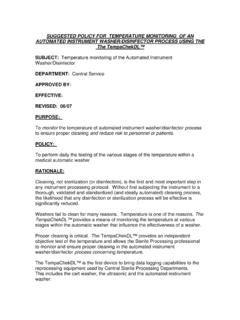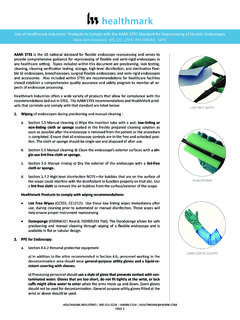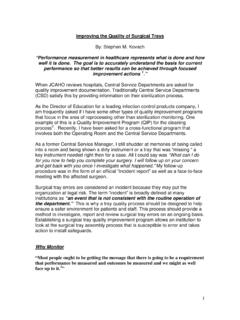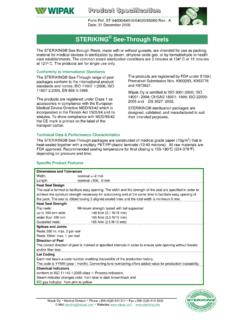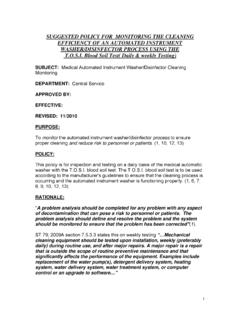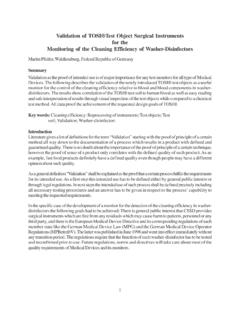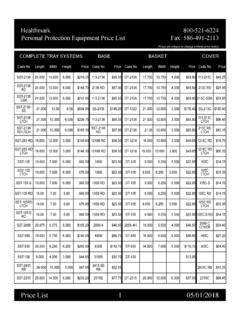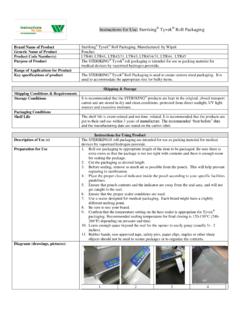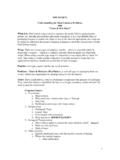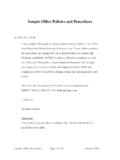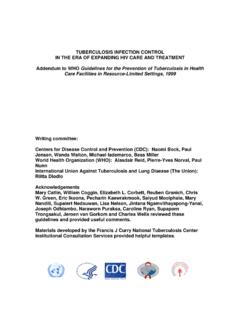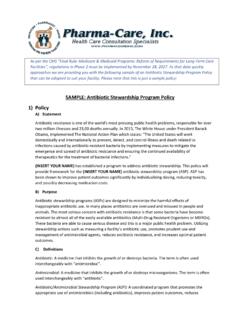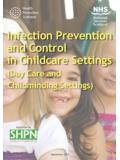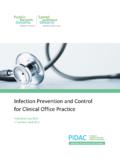Transcription of ATP policy updated November 2011 - HEALTHMARK
1 SUGGESTED policy for Using the ACCUP oint ATP Environmental Surface monitoring system SUBJECT: ATP Environmental Surface Monitoring DEPARTMENT: Sterile Processing Department APPROVED BY: EFFECTIVE: 11/ 2011 REVISED: 11/ 2011 PURPOSE: To monitor the cleanliness of environmental surfaces and to reduce risk to personnel or patients acquiring a hospital infection by using an ATP monitoring system. policy : ATP monitoring is designed to provide a method for healthcare facilities to monitor the effectiveness of their environmental surface cleaning efforts and make adjustments as The ATP monitoring system is to be used according to the manufacture's guidelines to ensure that the environmental surface cleaning process is occurring and reduce risk to staff and patients when it comes to hospital acquired infections (HAI).
2 2,3,4,5,6 RATIONALE : ATP monitoring is a common tool utilized in the food service industry to test a surface or food/beverages for contamination. More recently, ATP-based methods have emerged as a possible solution in the healthcare industry, specifically for verification of the cleanliness of environmental surfaces. HAIs are caused by a variety of pathogens, including Costridium difficile and Staphylococcus aureus. Data indicates that 13 out of every 1,000 patients in a survey were either infected or colonized with alone ( ). A study done by APIC National Prevalence on Clostridium difficile in US Health Care facilities showed that 7,178 inpatients are infected with alone on any given day.
3 This in turns increases the cost to a medical facility by increasing the length of stay for these patients. It was also noted that on average 301 patients per day die from Verifying a medical facilities environmental cleaning process is vital. Using an ATP system is part of that process. After any environmental cleaning, the amount of ATP that remains is a direct indication of cleaning effectiveness. Monitoring the environmental cleaning process will allow a medical facility to spot trends and adjust as needed their environmental cleaning process. What is ATP? ATP or adenosine triphosphate is the energy currency of all living cells, both human and microbial.
4 Cells can store energy as ATP for later use, making it a predominant molecule within cells. Since ATP cannot be produced by anything other than a living cell, it can be used as an indicator for the presence of viable cells. ATP testing entails the detection of bioluminescence or light emitted that is produced by a chemical reaction of ATP with firefly luciferase. An instrument, called a luminometer, is used to take the measurement of light. In essence, the same reaction that creates the light produced by a firefly produces light from ATP. The amount of light is directly proportional to the amount of ATP present.
5 The limit of detection of the test is quite sensitive; however, it does not differentiate the source of the ATP. As noted there is ATP in living eukaryotic (animal) and in self-replicating prokaryotic (microbial) cells. Detection of ATP on a cleaned environmental surface would indicate that it still has microorganisms or human cells on it. It should be noted that ATP is NOT present in viruses nor is it present in components such as protein, carbohydrate, hemoglobin, lipids, Environmental surface cleaning could be the top of a work area surface,an infusion pump surface,gomco pump,bed rail, wall, door knob,etc, this (environmental surface) is defined by the meidcal facility.
6 The basic concept of the testing process A swab that is free of any ATP is moistened with water, buffer, or a solution that breaks down cell membranes and destroys enzymes that degrade ATP. The area to be tested is then swabbed but depending on the system in use, a very specific surface area my need to be swabbed ( 10x10 cm2). The swab is placed into the solution in the swab holder, closed, and shaken. The swab is then placed in the luminometer, which determines the relative light units or RLU emitted from the swab. RLU values vary from system-to-system and are not a standard unit of measurement across systems.
7 Obtaining the number zero after testing is the optimal result. What to monitor Depending on the area and the equipment suggestions have been made by the CDC in there document entitled Options for Evaluating Environmental Cleaning .9 Other equipment found in the various departments can also be monitored beside the equipment and touch spots listed (suggested list is below). All available objects noted below should be marked in each room. Patient Area High Touch Object Bed control Phone and Call button Chair Light switch Sink top Flush handle Bed rails If the bed rail incorporates bed controls, evaluate the control area (on the patient side) slightly away from the control buttons.
8 If the rails do not contain the new style control areas, the rails are best evaluated on the smooth inner surface in an area easily accessible to cleaning. Tray table - The top of the tray table should be evaluated in one corner. Call boxes Evaluation is done on the back mid portion of the call box in an area easily accessible to cleaning. If tiny call buttons are used, mark the separate TV control box instead if feasible. Telephones Evaluation is best done on the back side of the hand-held portion of the telephone near the top of the phone, away from the end that is attached to the phone wire. Bedside tables The drawer pull is evaluated.
9 Patient chair Evaluation is done in the center of the seat of the chair close to the rear of the cushion. If the cushion is covered in textured fabric, evaluate the arm of the chair. IV pole For hanging IV poles, the shaft of the pole just above the textured grab area should be evaluated. For standing IV poles, the chest-high portion where hand contact is most common should be evaluated. Toilet Area Sinks If using a targeting system, the best place to mark the sink rim is towards the rear in order to avoid water splash interference with evaluation of the target. If direct evaluation is used, the faucet handle should be evaluated.
10 Bathroom and patient room light switches When using a targeting method, a target is placed on the plate portion of the light switch. When using a direct evaluation system, the switch or plate should be evaluated because of its relatively large surface area. Door knobs and door levers The inside door knob or lever is marked for each bathroom door and each patient room door. If using a targeting system on a round door knob, the mark is best placed as close to the middle of the face of the door knob as possible. If the knob has a locking mechanism, place the target on the circular door plate that surrounds the handle. Lever-type handles are marked on any easily cleanable surface somewhat away from the end of the lever where direct hand contact would be most frequent.
